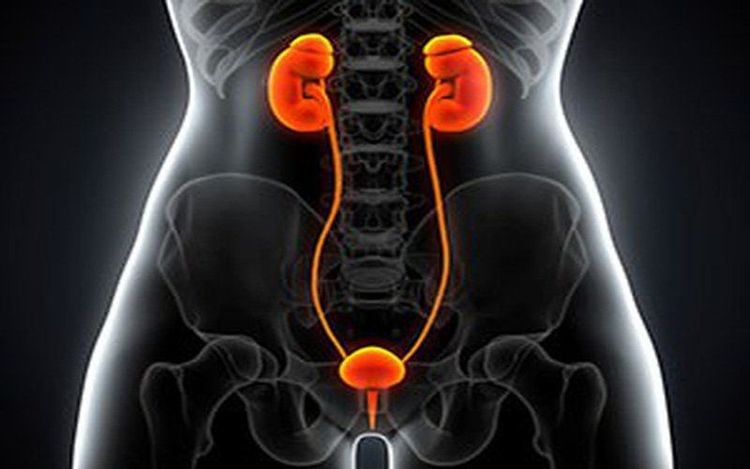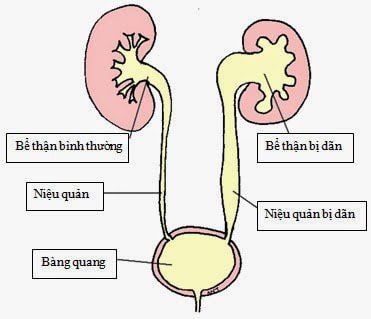This is an automatically translated article.
The article was professionally consulted by Specialist Doctor I Tran Cong Trinh - Radiologist - Radiology Department - Vinmec Central Park International General Hospital. The doctor has many years of experience in the field of diagnostic imaging.Renal pyelonephritis is one of the diseases that can have serious consequences. The ultrasonography of the renal pelvis is a necessary method to accurately diagnose and evaluate the medical condition, thereby having appropriate treatment methods, in order to limit dangerous complications for the patient.
1. What is pyelonephritis?
Renal pyelonephritis is a condition in which the kidneys are dilated due to fluid retention. When the kidneys are waterlogged and dilated for a long time, it will lead to enlargement or thinning, making the kidney look like a bag of water. Pyelonephritis can occur in the left kidney, the right kidney, or both kidneys. This prolonged condition can break at any time, or risk kidney failure, affecting the health of the patient. By stage, pyelonephritis is divided into 4 levels as follows:Grade 1: This is a mild degree of dilatation, so signs of pyelonephritis may not be of concern. If at this stage, the patient needs to see a doctor for regular monitoring of the kidneys and related organs. Grade 2: At this stage, the kidneys have shrunk due to extensive dilation of the renal calyces. Grade 3 and grade 4 pyelonephritis: This is the most severe level of pyelonephritis. When at this stage, the kidneys are stagnant water and the renal calyces have been stretched a lot. In this case, the doctor will prescribe surgery to stop the development of the disease.

Giãn đài bể thận có thể xảy ra ở cả hai bên thận
Kidney infection: Caused by long-term residual urine that causes disease-causing bacteria to grow, leading to inflammation and infection. Renal rupture: This complication is life-threatening. The cause of this complication is the excessively thin wall of the kidney combined with increased pressure in the kidney, causing the kidney to burst. Kidney failure: this is a silent complication that causes death for patients. Kidney cells are gradually destroyed, the function of filtering blood and eliminating toxic substances gradually disappears, making the patient increasingly exhausted. When kidney function is completely lost, the patient must undergo hemodialysis or a kidney transplant to maintain life.
2. Signs of renal calyces dilatation
There are many causes of renal pelvis dilatation. One of the main causes of this condition is kidney stone disease, ureteral stones that cause the ureteral tube to become blocked, urine is stagnant. In addition, urinary tract diseases such as cancer, bladder stones, prostate fibroids, bladder dysfunction, cervical cancer... can also lead to dilatation of the renal pelvis.As a disease that can endanger the patient's life, it is important to recognize the signs of pyelonephritis for timely treatment. Patients can observe and monitor the warning symptoms of pyelonephritis below:
Unusual abdominal pain appears, the pain may start from the back, hip and gradually spread to the groin area. sweating and nausea.

Giãn đài bể thận không được điều trị kịp thời có thể gây nguy hiểm tới tính mạng
3. Ultrasound of renal calyces dilatation
Ultrasound of the renal pelvis is a technique that helps doctors quickly detect and accurately diagnose the cause of the disease. Depending on the location of the kidney in the body, the doctor can choose the best view while the pyelonephritis is used to obtain vertical and horizontal images of the kidney. So can ultrasound detect signs of renal calyces dilatation? Accordingly, if the renal ultrasound is performed in an adult, the results are normal when the images have the following features:Kidneys are bean-shaped, with the navel in the interior, the sizes of the two kidneys are not the same; The border is regular, the left kidney parenchyma is triangular in shape. The renal cortex has a lower negative density, or it may also be equal to the liver and spleen; The renal pyramid has a slightly lower acoustic density than the cortical part, but the renal sinus complex has the greatest negative density. The normal collecting system is a narrow, inconspicuous urine-filled space that is clearly seen as a negative void in a person with good diuresis, and the renal pelvis can also appear from the level of a small acoustic drum structure in the kidney to large acoustic drum structure protruding from the kidney. As for children, the normal renal ultrasound image is different from that of adults as follows:
The glomeruli are more concentrated in the cortex, so the negative density is higher than that of the kidneys in adults. Young children have very little kidney fat, so the renal sinus complex consists only of the structures of the calyx system. The calyx system is stretched at about 75%, so the calyx and calyx are fluid-containing structures.

Siêu âm giãn đài bể thận là phương pháp chẩn đoán tình trạng bệnh lý hiệu quả
The renal pelvis and the renal calyces are slightly dilated if at level 1 The renal pelvis and calyces are dilated markedly, compression causes the renal parenchyma to narrow in the 2nd degree. The renal pelvis and calyx dilate into a large cyst, this stage will not distinguish the structures of the collecting system. Renal parenchyma is very thin. Ultrasound images of renal calyx dilatation can also see the location and reason of obstruction such as: ureteral stone. Ureteral junction - abnormal renal pelvis, malformation. Congenital ureteral atrophy. Tuberculosis of the kidney Insertion from the outside in such as lymph nodes, pelvic tumors, fetuses, cervical cancer, prostate fibroids,... Renal calyx dilatation is one of the diseases that can cause serious consequences. The ultrasonography of the renal pelvis is a necessary method to accurately diagnose and evaluate the medical condition, thereby having appropriate treatment methods, in order to limit dangerous complications for the patient.
Vinmec International General Hospital with a system of modern facilities, medical equipment and a team of experts and doctors with many years of experience in medical examination and treatment, patients can rest assured to visit. examination and treatment of pyelonephritis at the Hospital.
Please dial HOTLINE for more information or register for an appointment HERE. Download MyVinmec app to make appointments faster and to manage your bookings easily.
MORE
Renal dilatation in pregnant women Differential diagnosis of acute renal failure and chronic renal failure What is acute renal failure? Features of acute renal failure













